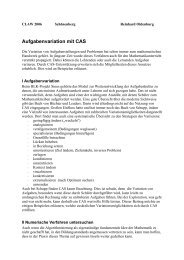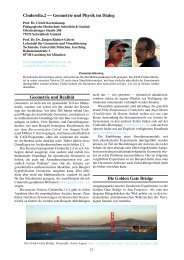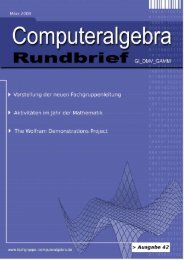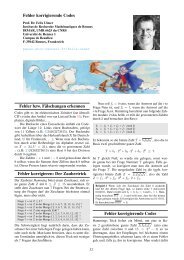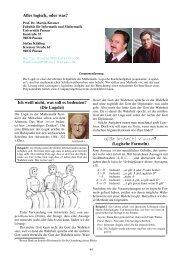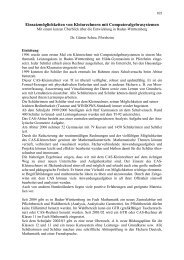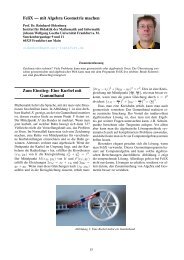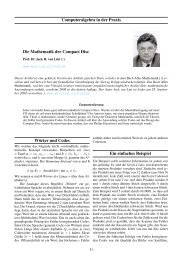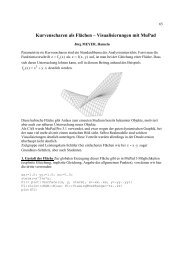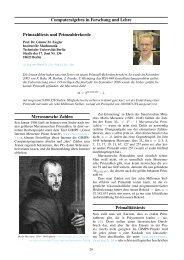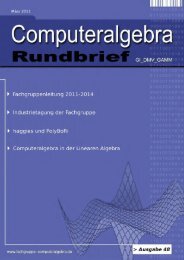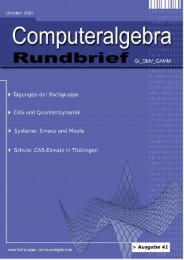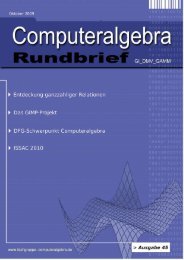Computeralgebra-Rundbrief - Fachgruppe Computeralgebra
Computeralgebra-Rundbrief - Fachgruppe Computeralgebra
Computeralgebra-Rundbrief - Fachgruppe Computeralgebra
Sie wollen auch ein ePaper? Erhöhen Sie die Reichweite Ihrer Titel.
YUMPU macht aus Druck-PDFs automatisch weboptimierte ePaper, die Google liebt.
ful (and interesting to work on). We also believed that<br />
building numerical and symbolic functionality as part<br />
of an integrated library would be more constructive than<br />
joining two separate libraries. This is a major direction<br />
in which our computation development has been moving<br />
for a long time.<br />
I have been very pleased with and proud of Mathematica<br />
5, because it brings many of these ideas to fruition.<br />
For a long time I have felt we could build such an<br />
application, and to actually succeed is very satisfying.<br />
I could make other points, for example, to point out<br />
that traditional numerical computation has always made<br />
use of symbolic techniques, though typically when<br />
it does they are not considered as symbolic techniques<br />
and are often described in language that hides the relation.<br />
Examples of this are graph theoretic approaches<br />
(the basis of direct sparse solvers and automatic differentiation.<br />
In Mathematica, we try to make this relation<br />
explicit.<br />
For the question of definition, I do not think that<br />
Wolfram Research has ever claimed that Mathematica<br />
is a computer algebra system. We have given more general<br />
definitions. ’A system for doing mathematics by<br />
computer’, was one early statement that I always liked.<br />
We certainly felt that it contained computer algebra, but<br />
from the very beginning worked to add other areas of<br />
functionality. In addition to numerical computation, we<br />
added graphics, a document interface, etc.<br />
CAR: How do the new ODE/PDE solvers compare<br />
to other, external, solvers? Do you take advantage of having<br />
the solver tightly integrated into a system capable<br />
of doing symbolic manipulations?<br />
TWJ: I think the new ODE/PDE solver is really quite<br />
unique in a number of important directions.<br />
1) The collection of built-in ODE methods is very<br />
large. I do not believe that any other single system provides<br />
such a wide collection.<br />
2) The system supports a plug-in mechanism. This<br />
is very important for people who want to develop new<br />
methods, allowing them to concentrate on the mathematics<br />
and not have to write code to process input, produce<br />
output, etc. This makes the development of new<br />
methods much more efficient because the framework is<br />
much more supportive–similar to the way that programming<br />
in Java is typically more efficient than programming<br />
in assembler.<br />
3) The system provides strong support for nested<br />
methods, i.e., a method that relies on some underlying<br />
method. For example, a projection method uses a base<br />
method to take a step which is then corrected to maintain<br />
some structural property of the system. Now, projection<br />
methods certainly existed before Mathematica 5, but the<br />
ease with which you can work with them, for example<br />
trying different base methods, is quite significant.<br />
4) Support for systems of equations is specified with<br />
vector or matrix input. That is, instead of writing all<br />
the equations explicitly, you can specify the equations<br />
as vectors or matrices. This leads to efficiencies in pro-<br />
20<br />
cessing the equations (which can lead to computational<br />
efficiencies). It also gives great notational simplification<br />
to the user of the system. In addition, it is obviously<br />
useful if you actually want to use differential equation<br />
techniques for solving matrix problems.<br />
In addition, there are the long-standing benefits of<br />
solving differential equations in Mathematica. In a way,<br />
these are so obvious that they get overlooked. These include<br />
the fact that you just enter differential equations to<br />
the solver as you would see them in a paper or in a book.<br />
In many systems you have to rewrite the equations manually,<br />
to a traditional form for a numerical solver. It<br />
also includes the fact that the output of the solver is not<br />
just a collection of numbers, it is a first-class Mathematica<br />
object, a representation of the function that satisfies<br />
the equation (implemented as a piecewise polynomial).<br />
This can be used in all other mathematical computations,<br />
e.g., it can be differentiated, used in an optimization<br />
equation or used to solve another ODE.<br />
I’m not an expert on differential equations<br />
in Mathematica. More information can be<br />
found at http://documents.wolfram.com/v5/<br />
Built-inFunctions/AdvancedDocumentation/<br />
DifferentialEquations/NDSolve/index.html.<br />
CAR: For our readers it is of high interest that it is<br />
now possible to solve equations and inequalities symbolically<br />
over fields other than the reals. How do the methods<br />
compare to the methods used in earlier versions<br />
of Mathematica?<br />
TWJ: Mathematica 4 only solved systems of equations<br />
over complex numbers, and the only methods used<br />
were linear algebra for linear systems, Groebner bases<br />
for polynomial systems, and a few heuristics for transcendental<br />
systems. Mathematica 5 can solve systems<br />
of algebraic equations and inequalities over the reals<br />
using cylindrical algebraic decomposition (Mathematica<br />
4 has an earlier version of CAD, which was hidden<br />
in the Experimental‘ context), can solve systems<br />
involving quantifiers, has algorithms and heuristics giving<br />
complete solutions of (some) transcendental systems<br />
over the complex and the real numbers, has 25 or<br />
so algorithms and heuristics for solving various types of<br />
Diophantine equations and inequalities, and can solve<br />
quantified linear and polynomial systems over integers<br />
modulo m using modular linear algebra and Groebner<br />
basis methods. (Mathematica 4 had some of the functionality<br />
using the Mode → Modular option, but it was<br />
a rather awkward syntax, and not always reliable.)<br />
CAR: Sophisticated pattern matching is crucial for<br />
almost everything in Mathematica. How does “A New<br />
Kind of Science”, the book of Stephen Wolfram, influence<br />
the further development of the Mathematica kernel?<br />
TWJ: The relationship between NKS and Mathematica<br />
is quite interesting. In one sense NKS is a large<br />
application of Mathematica. It might not have been possible<br />
without Mathematica, but its work gives us many<br />
ideas for extending and developing Mathematica to ma-



